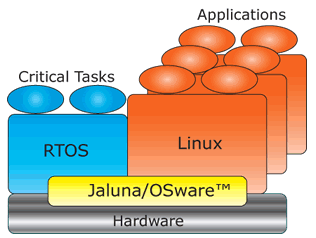IP-STB design runs Linux, real-time codecs on single DSP core
Sep 15, 2004 — by LinuxDevices Staff — from the LinuxDevices Archive — 3 viewsJaluna has developed technology that lets uClinux run alongside the native DSP/BIOS application environment on a single-core DSP (digital signal processor). The technology can be used to build inexpensive IP-STBs based on Texas Instruments DSPs. Jaluna has partnered with codec vendor Ateme to demo a single-DSP IP-STB software implementation.
Most media processing systems today use a combined RISC/DSP dual-core architecture in which signal processing (typically compression and decompression) happens in real time on the DSP while the RISC core runs an OS and applications for the user interface, networking, and other less real-time functions. Jaluna says its technology will enable complete IP-STBs and other media-centric systems to be built on hardware with only a single DSP core.
The technology is based on Jaluna's OSware virtual platform technology, introduced in May. OSware includes an “NK2” nanokernel, said to divide hardware resources among multiple operating environments while preserving the real-time capabilities of each. It also provides a virtual bus for interOS communication and an optional software watchdog component.

OSware enables multiple application environments, including Linux, to share a single processor, including a single DSP
The Jaluna IP-STB design is based on a Texas Instruments TMS320DM64x, the same DSP coaxed into running Linux earlier by Softier, in what may have been the first-ever port of a full-featured Linux OS to a single-core DSP (though Metrowerks claims that its port of uClinux to the Analog Devices BlackFin DSP occurred first). Softier's MediaLinux was since used in a single-core DSP IP-STB reference design from X-Digital Systems, which is also available as a finished product, the Flik-It. Softier also markets a single-core DSP IP-STB reference design based on a TI DM64x DSP.
According to Jaluna, OSware allows the Linux and DSP/BIOS environments to run independently and concurrently on the same media processor. “This avoids any GPL contamination of DSP/BIOS services, drivers and applications,” it adds.
Jaluna's dual-application environment, single-DSP technology is based on a uClinux 2.4.20 kernel with “standard real-time patches,” with a port to Linux 2.6 expected before 2005. It also includes Linux root file system with C library and POSIX API tailored for a tiny memory footprint, and standard Linux applications such as Video Lan customized for embedded and MMU-less processors.
The other “application environment” in the equation is the DSP's native DSP/BIOS, which supports “expressDSP-compatible multimedia codecs from TI's many third party vendors,” Jaluna says. For its own IP-STB reference design, Jaluna has teamed with A/V codec vendor Ateme.
Jaluna recently secured $12 Million in series A funding from Atlas Venture, Index Ventures, and Cisco Systems, it says.
This article was originally published on LinuxDevices.com and has been donated to the open source community by QuinStreet Inc. Please visit LinuxToday.com for up-to-date news and articles about Linux and open source.